VITEE-2016 Solved Paper
PART II
CHEMISTRY
1. IUPAC name of valeric acid is
(a) Propanoic acid
(b) Butanoic acid
(c) Ethanoic acid
(d) Pentanoic acid
2. 
The product P for the above given reaction will be
(a) m-nitroaniline
(b) o-nitroaniline
(c) p-nitroaniline
(d) both o & p nitroaniline
3. Coordination number of Co in[Co(NH3)6]Cl3
(a) +2
(b) +3
(c) +5
(d) +8
4. Which of the following complex will show fac & mer isomerism?
(a) [Co(NH3)3(NO2)3]
(b) [CoCl2(en)2]+
(c) [(Co(NH3)Cl(en)2]2+
(d) [Co(NH3)2Cl2(en)]+
5. Which of these undergo polymerization?
(a) CH3OH
(b) C2H5OH
(c) 
(d) CH3CHO
6. Which of the following graph represents variation of 2p-orbital wave function with distance from the nucleus
(a) 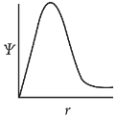
(b) 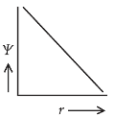
(c) 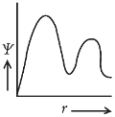
(d) 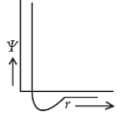
7. Name the catalyst used to bring down the reaction
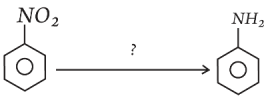
(a) Sn/HCl
(b) CuCl/HCl
(c) Cu2Cl2/HCl
(d) Zn-Hg/HCl
8. The correct set of quantum numbers for Rb (atomic no. 37) is
(a) ![]()
(b) ![]()
(c) ![]()
(d) ![]()
9. XeF4 disproportionate in water to give
(a) Xe + HF
(b) Xe and XeO3
(c) XeOF4 and HF
(d) XeO2Fe and HF
10. An ionic compound has a unit cell consisting of A ions at the corners of a cube and B ions on the centres of the faces of the cube. The empirical formula for this compound would be
(a) A3B
(b) AB3
(c) A2B
(d) AB
11. Among the following the incorrect statement is
(a) Density of crystals remains unaffected due to Frenkel defect.
(b) In BCC unit cell the void space is 32%.
(c) Density of crystals decreases due to Schottky defect
(d) Electrical conductivity of semiconductors and metals increases with increase in temperature.
12. 
The correct order of electrophilic substitution for the compounds given above will be
(a) A > B > C
(b) C > B > A
(c) B > C > A
(d) B > A > C
13. For mesotartaric acid, the correct configuration for chiral carbon is
(a) 2R, 3S
(b) 2R, 3R
(c) 2S, 3R
(d) 1D, 2L
14. Which of the two acids form anhydrides?
(I) Oxalic acid (II) Succinic acid
(III) Benzoic acid (IV) Phthalic acid
(a) I & III
(b) II & IV
(c) II & III
(d) III & IV
15. By which reaction ketal is formed?
(a) Glycol with acetone
(b) Hydration of glycol
(c) Condensation of glycol
(d) Glycol with acetaldehyde
16. Which one of the following show stereoisomerism?
(a) 2-Butene
(b) 3-Methyl but-1-ene
(c) 2-Methyl butene
(d) Butanol
17. Acetophenone and Benzophenone can be distinguished by which of the following test
(a) Knoeveangel reaction
(b) Canizzaro’s reaction
(c) Aldol condensation
(d) HVZ Reaction
18. ![]()
The product P in this reaction is
(a) R – NH2
(b) ![]()
(c) R – CH3
(d) R – N – (CH3)2
19. The protein present in the hair is
(a) Lysine
(b) Myosine
(c) Keratin
(d) Alanine
20. One mole of an ideal gas at 300 K is expanded isothermally from an initial volume of 1 litre to 10 litres. Then ∆S (cal deg−1 mol−1) for this process is : (R = 2 cal K−1 mol−1)
(a) 7.12
(b) 8.314
(c) 4.6
(d) 3.95
21. For a reaction A → B; ∆H = 20 kJ mol−1 the activation energy of the forward reaction is 85 kJ/mol. The activation energy of the backward reaction will be
(a) 105 kJ/mol
(b) 65 kJ/mol
(c) 45 kJ/mol
(d) 75 kJ/mol
22. If the reaction N2 + 3H2 = 2NH3 occurs at 200℃ and 1000 atm then the graph showing the correct equilibrium yield at 400℃ is
(a) 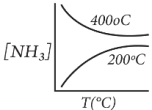
(b) 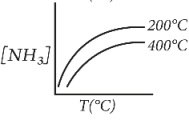
(c) 
(d) 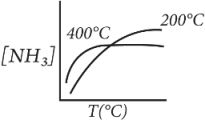
23. Group 15 elements have more electron gain enthalpy than group 16-elements. The correct reason for this is
(a) Half-filled stability of gp. 15 elements.
(b) Poor shielding in gp. 15
(c) Poor shielding in gp. 16
(d) Half-filled stability of gp. 16 elements.
24. t-butyl ![]() can’t give decarboxylation while normally α-β unsaturatetd acid give this reaction because
can’t give decarboxylation while normally α-β unsaturatetd acid give this reaction because
(a) t-butyl gp. has large size and does not let the COOH group to leave.
(b) t-butyl gp. can’t extract H from COOH.
(c) t-butyl gp. stabilize carbanion formed.
(d) t-butyl gp. does not allow this composition to convert to β-γ-unsaturated acid
25. Which type of carbocation is/are formed when  is treated with an acid?
is treated with an acid?
(a) 1°
(b) 2°
(c) 3°
(d) All the three
26. For hydrogen-oxygen fuel cell, the cell reaction is 2H2(g) + O2(g) → 2H2O(ℓ)
If ∆Gf°(H2O) = −237.2 kJ mol−1, then emf of this cell of
(a) +2.46 V
(b) −2.46 V
(c) +1.23
(d) −1.23 V
27. At 298 K, the conductivity of a saturated solution of AgCl in water is 2.6 × 10−6 Scm−1. It solubility product at 298 K.
Given : λ∞ (Ag+) = 63.0 S cm2 mol−1
λ∞ (Cl−) = 67.0 S cm2 mol−1
(a) 2.0 × 10−5 M2
(b) 4.0 × 10−10 M2
(c) 4.0 × 10−16 M2
(d) 2 × 10−8 M2
28. Standard entropy of X2, Y2 and X Y3 are 60, 40 and 50 JK−1 mol−1, respectively. For the reaction, ![]() to be at equilibrium, the temperature will be
to be at equilibrium, the temperature will be
(a) 1250 K
(b) 500 K
(c) 750 K
(d) 1000 K
29. The enthalpy change for a given reaction at 298 K is –x J mol−1. For the reaction to be spontaneous at 298 K, the entropy change at that temperature.
(a) can be negative, but numerically greater than ![]()
(b) can be negative, but numerically smaller than ![]()
(c) can not be negative
(d) can not be positive
30. a moles of PCl5 is heated in a closed container to equilibriate PCl5(g) ⇌ PCl3(g) + Cl2(g) at a pressure of P atm. If x moles of PCl5 dissociate at equilibrium, then
(a) ![]()
(b) 
(c) 
(d) 
31. A plot of ln K against 1/T (abscissa) is expected to be a straight line with intercept on ordinate axis equal to
(a) ![]()
(b) ![]()
(c) ![]()
(d) ![]()
32. In a reaction A → Products, when start is made from 8.0 × 10−2 M of A, half-life is found to be 120 minute. For the initial concentration 4.0 × 10−2 M, the half-life of the reaction becomes 240 minute. The order of the reaction is
(a) zero
(b) one
(c) two
(d) 0.5
33. A reaction : A2 + B → Products, involves the following mechanism :
A2 ⇌ 2A (fast)
(A being the intermediate).
![]() Products (slow). The rate law consistent to this mechanism is :
Products (slow). The rate law consistent to this mechanism is :
(a) rate = k[A2][B]
(b) rate = k[A2]2[B]
(c) rate = k[A2]1/2[B]
(d) rate = k[A2][B]2
34. The following data were obtained for given reaction at 300 K.
Reaction Energy of activation (kJ mol−1)
(i) uncatalyzed 76
(ii) catalyzed 57
The factor by which rate of catalyzed reaction is increased, is
(a) 21
(b) 2100
(c) 2000
(d) 1200
35. The wave number of first emission line in the Balmer series of H-Spectrum is:
(R = Rydberg constant) :
(a) ![]()
(b) ![]()
(c) ![]()
(d) ![]()
36. Which one of the following reactions of xenon compounds is not feasible?
(a) 3XeF4 + 6H2O → 2Xe + XeO3 + 12HF + 1.5O2
(b) 2XeF2 + 2H2O → 2Xe + 4HF + O2
(c) XeF6 + RbF → Rb[XeF7]
(d) XeO3 + 6HF → XeF6 + 3H2O
37. Anisole is treated with HI under two different conditions.
![]()
The nature of A to D will be
(a) A and B are CH3I and C6H5OH, while C and D are CH3OH and C6H5I
(b) A and B are CH3OH and C6H5I, while C and D are CH3I and C6H5OH
(c) Both A and B as well as both C and D are CH3I and C6H5OH
(d) A and B are CH3I and C6H5OH, while there is no reaction in the second case.
38. Phenol undergoes electrophilic substitution more easily than benzene because
(a) ―OH group exhibits +M effect and hence increases the electron density on the o- and p-positions.
(b) oxocation is more stable than the carbocation
(c) both (a) and (b)
(d) −OH group exhibits acidic character
39. Which of the following name reaction is not used for introducing a –COOH group?
(a) Cannizzaro reaction
(b) Benzilic acid rearrangement
(c) Baeyer – Villiger oxidation
(d) Iodoform reaction
40. Esterification of acid chloride with ethanol is usually carried out in the presence of pyridine. The function of pyridine is
(a) to remove HCl formed in the reaction
(b) to react with acid chloride to form an acylpyridinium ion
(c) both (a) and (b)
(d) as a catalyst
Latest Govt Job & Exam Updates: